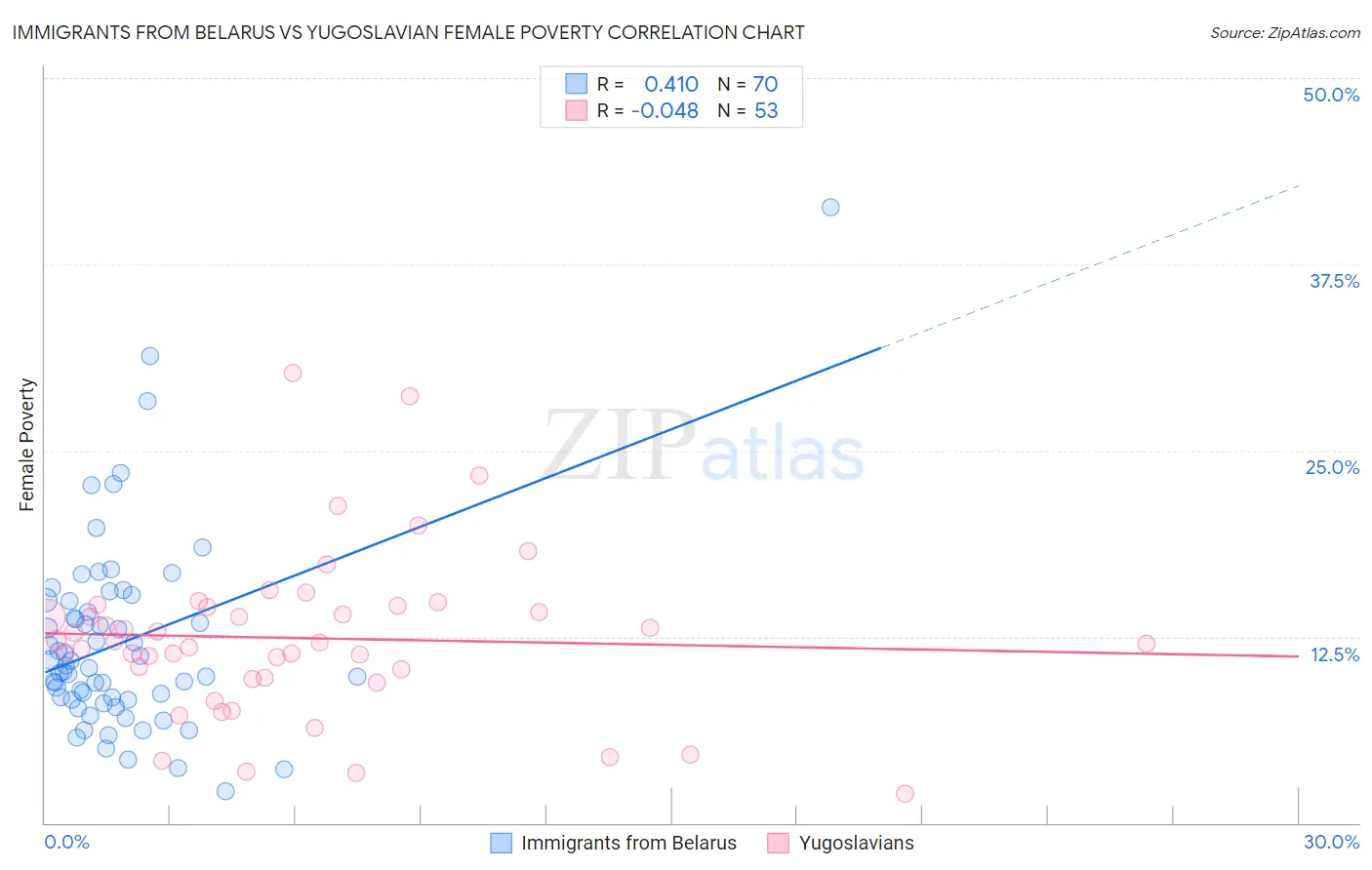Immigrants from Belarus vs Yugoslavian Female Poverty
COMPARE
Immigrants from Belarus
Yugoslavian
Female Poverty
Female Poverty Comparison
Immigrants from Belarus
Yugoslavians
12.8%
FEMALE POVERTY
88.2/ 100
METRIC RATING
128th/ 347
METRIC RANK
13.1%
FEMALE POVERTY
76.9/ 100
METRIC RATING
148th/ 347
METRIC RANK
Immigrants from Belarus vs Yugoslavian Female Poverty Correlation Chart
The statistical analysis conducted on geographies consisting of 150,175,369 people shows a moderate positive correlation between the proportion of Immigrants from Belarus and poverty level among females in the United States with a correlation coefficient (R) of 0.410 and weighted average of 12.8%. Similarly, the statistical analysis conducted on geographies consisting of 285,591,967 people shows no correlation between the proportion of Yugoslavians and poverty level among females in the United States with a correlation coefficient (R) of -0.048 and weighted average of 13.1%, a difference of 2.1%.

Female Poverty Correlation Summary
| Measurement | Immigrants from Belarus | Yugoslavian |
| Minimum | 2.1% | 2.0% |
| Maximum | 41.3% | 30.2% |
| Range | 39.2% | 28.2% |
| Mean | 12.1% | 12.4% |
| Median | 10.5% | 12.1% |
| Interquartile 25% (IQ1) | 8.3% | 9.7% |
| Interquartile 75% (IQ3) | 14.9% | 14.5% |
| Interquartile Range (IQR) | 6.6% | 4.8% |
| Standard Deviation (Sample) | 6.5% | 5.5% |
| Standard Deviation (Population) | 6.5% | 5.5% |
Demographics Similar to Immigrants from Belarus and Yugoslavians by Female Poverty
In terms of female poverty, the demographic groups most similar to Immigrants from Belarus are Immigrants from Brazil (12.8%, a difference of 0.070%), Immigrants from Vietnam (12.8%, a difference of 0.27%), Immigrants from Argentina (12.8%, a difference of 0.30%), Immigrants from Jordan (12.8%, a difference of 0.31%), and Immigrants from Western Europe (12.8%, a difference of 0.37%). Similarly, the demographic groups most similar to Yugoslavians are Immigrants from Kazakhstan (13.0%, a difference of 0.25%), Immigrants from Peru (13.0%, a difference of 0.33%), Syrian (13.0%, a difference of 0.40%), Afghan (13.0%, a difference of 0.43%), and Immigrants from Malaysia (13.0%, a difference of 0.52%).
| Demographics | Rating | Rank | Female Poverty |
| Immigrants | Belarus | 88.2 /100 | #128 | Excellent 12.8% |
| Immigrants | Brazil | 87.9 /100 | #129 | Excellent 12.8% |
| Immigrants | Vietnam | 87.1 /100 | #130 | Excellent 12.8% |
| Immigrants | Argentina | 87.0 /100 | #131 | Excellent 12.8% |
| Immigrants | Jordan | 86.9 /100 | #132 | Excellent 12.8% |
| Immigrants | Western Europe | 86.6 /100 | #133 | Excellent 12.8% |
| Immigrants | Switzerland | 85.8 /100 | #134 | Excellent 12.9% |
| French | 85.6 /100 | #135 | Excellent 12.9% |
| Peruvians | 85.2 /100 | #136 | Excellent 12.9% |
| Chileans | 84.7 /100 | #137 | Excellent 12.9% |
| Immigrants | France | 83.6 /100 | #138 | Excellent 12.9% |
| Basques | 83.1 /100 | #139 | Excellent 12.9% |
| Pakistanis | 83.0 /100 | #140 | Excellent 12.9% |
| Icelanders | 81.1 /100 | #141 | Excellent 13.0% |
| Brazilians | 80.5 /100 | #142 | Excellent 13.0% |
| Immigrants | Malaysia | 80.4 /100 | #143 | Excellent 13.0% |
| Afghans | 79.8 /100 | #144 | Good 13.0% |
| Syrians | 79.6 /100 | #145 | Good 13.0% |
| Immigrants | Peru | 79.1 /100 | #146 | Good 13.0% |
| Immigrants | Kazakhstan | 78.6 /100 | #147 | Good 13.0% |
| Yugoslavians | 76.9 /100 | #148 | Good 13.1% |